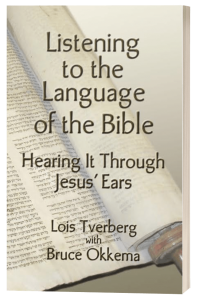The first of the two great commandments, according to Jesus, is to love the Lord your God with all of your heart, soul and strength. Jesus goes on to say that the second one is like it—to love your neighbor as yourself (Matt 22:35-37).
The overwhelming importance of this second command is echoed in the rest of the New Testament. Peter says “above all, love one another” (1 Peter 4:8), and in the letters of John, that “this was the teaching you have heard from the very beginning—to love one another” (1 John 3:11).
While the incredible richness of the words “love your neighbor as yourself” is already apparent to us, hearing more about Jesus’ words in their Jewish context will deepen our understanding of this saying and link it to other teachings of his.
The Link between Loving God and Your Neighbor
Just as the first of the two great commandments, to love the Lord, is from the Old Testament (Deut. 6:5), the command to “love your neighbor” is from there too. In Leviticus 19:18 it says,
You shall not take vengeance, nor bear any grudge against the sons of your people, but you shall love your neighbor as yourself; I am the LORD.
Even before Jesus was on the scene, his fellow rabbis had been thinking about “what is the great commandment of the Torah,” and they answered it by linking the two passages: “And you shall love the Lord your God with all of your heart, and all of your soul, and all of your strength,” and, “and/but you shall love your neighbor as yourself.”
They had an interesting way of linking them together, called gezerah sheva, which is the practice of connecting verses that share a word or phrase relatively unique to them. In this case, those verses were linked because they share the Hebrew word ve’ahavta, which means, “and you shall love”. This exact phrase is used only in these two Old Testament passages, and one other time.
The rabbis suggested that since both verses start with the command to love, that they could be understood together as if one was expanding on the other as an explanation of how to love. So the greatest commandment of the Law, the klal gadol ba Torah (great principle of the Torah) was to love your neighbor, by which you demonstrated your love for God. Paul and the other New Testament writers are echoing both Jesus and other rabbinic thought when they say that, “The entire law is summed up in a single command: ‘Love your neighbor as yourself.'” (Gal. 5:14), or that loving your neighbor is the “royal law” (James 2:8).
Interpreting “Loving Your Neighbor As Yourself”
The commonly understood interpretation is that we should love others with the same measure that we love ourselves, which is certainly very true! But the rabbis also saw that the Hebrew of that verse can also be read as, “Love your neighbor who is like yourself.” While either interpretation is valid, their emphasis was less on comparing our love of ourselves with our love for others, and more on comparing other people to ourselves, and then loving them because they are like us in our own frailties.
This actually fits the original context of Lev. 19:18 better, which says, “You shall not take vengeance, nor bear any grudge against the sons of your people, but you shall love your neighbor, as/like yourself; I am the LORD.” When we realize that we are guilty of the same sins that others are, we see that we shouldn’t bear grudges against them, but to forgive and love them instead.
The rabbis of Jesus’ day saw it as a challenge to realize that we are to love those who do not seem worthy because we ourselves are unworthy, and all are in need of God’s mercy. All people, including ourselves, are flawed and sinful, but we need to love them because we ourselves commit the same sins. One rabbi said,
If you hate your neighbor whose deeds are wicked like your own, I, the Lord, will punish you as your judge; and if you love your neighbor whose deeds are good like your own, I, the Lord, will be faithful to you and have mercy on you. (Avot de-Rabbi Natan, Version B, chap. 26)
Another rabbi said:
Forgive your neighbor’s injustice; then, when you pray, your own sins will be forgiven. Should a person nourish anger against another, and expect healing from the Lord? Should a person refuse mercy to a man like himself, yet seek pardon for his own sins? (28:2-4) (Ben Sira, c. 180 B.C.)
While what we have always understood as Christians about loving our neighbor as ourselves still remains true, the rabbis’ perspective highlights the fact that the time when we need to show love most is when we need to forgive others’ sins against us.
We can even hear the background of the verse of the Lord’s Prayer that says, “Forgive us our sins as we forgive those who sin against us.” We could almost say, “Please love us even though we are sinners, as we love other sinners like ourselves.”
Forgiving sins is one of the strongest tests of love —it is easy to love someone who has treated us rightly, but to love someone who has hurt us is far more difficult. God must love us greatly if he keeps forgiving the sins we commit against him!
Another thing that the rabbis would point out from the phrase “Love your neighbor who is like you,” is that all humans are made in the image of God, and all are precious to him. When we are furious with terrorists who fly our planes into our buildings, it is easy to imagine that such people are animals, not even real persons. Every genocide starts with the idea that the enemy is not fully human. But if we remember that even the most wicked person bears the stamp of God’s image on him, we still must treat them with justice, and never forget their humanity.
Who is my Neighbor?
In Luke 10, when Jesus is having a discussion with a lawyer about “loving your neighbor,” the lawyer asks him the question “And who is my neighbor?” We assume that this is not a legitimate question, but it actually was a very good question. In Hebrew, the word reah was used for neighbor, but it was even more commonly used for friend. So the verse could be interpreted, “Love your friend who is like you” or “Love your friend as yourself,” which isn’t much of a challenge at all. The lawyer probably already understood that it didn’t just apply to one’s friends, it applied to one’s neighbors in a broader sense. The rabbinic debate was about how far that circle went, and he was asking Jesus just how far he thought that circle extended.
Jesus gave the lawyer a brilliant answer to how far the circle went: he told the parable of the Good Samaritan, and then asked the lawyer who was the neighbor to the dying man, which was the despised Samaritan (Luke 10). We would expect the answer to the question “Who is my neighbor” to be “the dying man.” But Jesus asked the question in such a way as to force the man to say that the neighbor was in fact, the Samaritan. In Jesus’ time the Samaritans and Jews despised each other as enemies, so Jesus’ implication is that we should go so far as to love even those who are not our friends.
By telling this parable, Jesus brilliantly used rabbinic technique to elevate third and final verse in the Old Testament verse that contains the word “ve’ahavta” to the level of the other two. It is Leviticus 19:34:
The stranger who resides with you shall be to you as the native among you, and you shall love him as yourself, for you were aliens in the land of Egypt; I am the LORD your God.
The Samaritan would have been the stranger and the alien among them, and Jesus shows that the stranger and alien was the neighbor that the man should love! It seems that Jesus is tying “Love your neighbor” with “love the stranger” and even “love your enemies”! This saying was utterly unique to Jesus, and while he built it on rabbinic thought of his time, it goes far beyond that. It is amazing to see how our rabbi Jesus began with this rich material and brought it to its pinnacle.
More Light on the Samaritan
Jesus’ teaching grows even richer if we see his parable about the Good Samaritan in the light of a story in his Scripture that was in the background. (Remember that the entire first century Jewish culture was very biblically literate, and rabbis frequently alluded to their scriptures to give more depth to their stories.)
In 2 Chronicles 28:8-15, a scene takes place after Israel is divided into the two kingdoms of Israel and Judah. Ahaz, the king of Judah, led the nation into terrible idolatry, even sacrificing children to idols. Because of this, the Lord let Judah be attacked and defeated by Israel. This is the first time that Israel actually took prisoners of the tribes of Judah.
They were on the verge of leading 200,000 of them away as their slaves, but a prophet chastised them, reminding them that God let them defeat Judah as a punishment for idolatry, and they were even more guilty of worshipping idols than their brothers. He told them that if they took their own brothers captive, it would compound their guilt before the Lord. So some of the leaders of the tribes repented of their sin and set the Judeans free. It says,
Then the men who were designated by name arose, took the captives, and they clothed all their naked ones from the spoil; and they gave them clothes and sandals, fed them and gave them drink, anointed them with oil, led all their feeble ones on donkeys, and brought them to Jericho, the city of palm trees, to their brothers; then they returned to Samaria. (2 Chron. 28:15)
We rarely read of a story of such compassion between nations at war, where one binds the wounds of the other and gently restores them to freedom. This was a remarkable moment of grace between the tribes of Israel. These “good Samaritans” appear to be in the background of Jesus’ character of the Samaritan in his parable for several reasons.
In the parable, Jesus mentions the town Jericho, one of the few times he ever mentions specific places in parables. The victim is stripped naked, like some of the Judeans were, and the Samaritan anoints the man and puts him on a donkey and carries him to Jericho, like was done with the Judeans. His audience easily could have brought to mind this story.
If Jesus had this in mind, it shows us even more brilliance packed into his parable. In this story of the ancient “good Samaritans,” the point at which they repented and decided to love their enemies was exactly when they became aware of the truth of Leviticus 19:18—that their enemies were their own brothers, and that they were sinners just like them! They were loving their neighbors, because they realized they were alike both in humanity and sinfulness. To the audience of Jesus’ parable, they would have remembered that the Samaritans actually did at one time perform this act of great compassion for their enemies, which was Israel. And that they should act like these people (and love these people), who then were their worst enemies.
What are the implications?
It is hard to overstate the depth and brilliance of Jesus in his rabbinic teaching. He builds on Old Testament stories and and rabbinic thought to express an idea that was unique to him—that we should even love our enemies. Why? Because they are human beings, made in the image of God like ourselves, and because we are all sinners in God’s sight. Just as God loves both the just and the unjust, how much more, we who are sinners, should love other sinners like ourselves.




 In a later source, the Babylonian Talmud, it says “He who judges his neighbor favorably will be judged favorably by God” (Shabbat 127a). It is interesting to see how reminiscent this is of Jesus’ saying, “with the measure you use, it will be measured to you.” To “judge in favorable terms” was considered as important as visiting the sick, devotion in prayer, or teaching the Scriptures to your children!
In a later source, the Babylonian Talmud, it says “He who judges his neighbor favorably will be judged favorably by God” (Shabbat 127a). It is interesting to see how reminiscent this is of Jesus’ saying, “with the measure you use, it will be measured to you.” To “judge in favorable terms” was considered as important as visiting the sick, devotion in prayer, or teaching the Scriptures to your children! What would happen if each group stopped assigning negative motivations to the other group? What if the “hymns only” group started saying, “Maybe the younger members of our church think that they can bring new meaning to the service by putting it in their own style…” What if the “rock band” enthusiasts started saying, “Maybe the older members find more meaning in what’s familiar rather than in what sounds strange to them…”
What would happen if each group stopped assigning negative motivations to the other group? What if the “hymns only” group started saying, “Maybe the younger members of our church think that they can bring new meaning to the service by putting it in their own style…” What if the “rock band” enthusiasts started saying, “Maybe the older members find more meaning in what’s familiar rather than in what sounds strange to them…” While we can discern sin in practice, only God knows the motive of the heart. We need to leave final judgment up to him. To judge another is to presume to have both the knowledge and authority of God himself. So when we are in a situation where we are tempted to condemn someone, we need to step back, hand the situation over to the Lord, and remind ourselves that it is his job to render judgement, not ours. As we read in James 4:12, “There is only one Lawgiver and Judge, the One who is able to save and to destroy; but who are you who judge your neighbor?”
While we can discern sin in practice, only God knows the motive of the heart. We need to leave final judgment up to him. To judge another is to presume to have both the knowledge and authority of God himself. So when we are in a situation where we are tempted to condemn someone, we need to step back, hand the situation over to the Lord, and remind ourselves that it is his job to render judgement, not ours. As we read in James 4:12, “There is only one Lawgiver and Judge, the One who is able to save and to destroy; but who are you who judge your neighbor?”














